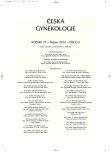Adrenocorticotropin hormone – possible marker of pregnancy pathologies
Authors:
Z. Hodická 1; J. Bienertová-Vašků 2,3; P. Ventruba 1; A. Vašků 2
Authors‘ workplace:
Gynekologicko-porodnická klinika LF MU a FN Brno, přednosta prof. MUDr. P. Ventruba, DrSc., MBA
1; Ústav patologické fyziologie FM MU Brno, přednosta prof. MUDr. A. Vašků, CSc.
2; Klinika dětské onkologie, FN Brno, přednosta prof. J. Štěrba, Ph. D.
3
Published in:
Ceska Gynekol 2012; 77(2): 142-144
Category:
Original Article
Overview
Adrenocorticotropin hormone (ACTH) is produced from the anterior pituitary gland and can be considered as one of the main elements of the hypothalamic-pituitary-adrenal axis. ACTH secretion is controled by corticotropin-releasing hormone (CRH) from hypothalamus. ACTH stimulates the adrenal cortex. It’s affects synthesis and releasing of glucocorticoids, precursors of aldosterone, which affects the synthesis of mineralocorticoids. Preeclampsia and intrauterine growth retardation (IUGR) is one of the major pregnancy pathologies. The aetiology of these states are not clearly known, it is assumed that factors pathogenetic chain has been operating in early pregnancy. These factors are generally similar for both diseases. It is assumed that these pathologies will activate the hypothalamic-pituitary-adrenal stress axis both for mother and fetus. In research studies, mathernal plasma CRH concentrations are elevated in complicated pregnancies. Etiopathogenesis of severe pregnancy pathologies such as IUGR, or preeclampsia is still unclear. Therefore, the research focuses on finding new markers that contribute to early diagnosis of serious states.
Key words:
adrenocorticotropin hormone, corticotropin-releasing hormone, pregnancy, preeclampsia, uteroplacental insufficiency.
Sources
1. Ahmed, I., Glynn, B., Perkins, AV., et al. Processing of procorticotropin-releasing hormone (pro-CRH): molecular forms of CRH in normal and preeclamptic pregnancy. J Clin Endocrinol Metab, 2000, 85, p. 755.
2. Ganong, WF. Přehled lékařské fyziologie. Jinočany: H&H, 1995, 333 s.
3. Chatterjee, A., Chatterjje, R. How stress affects female reproduction. Biomed Res, 2009, 20, p. 2009-05.
4. Karteris, E., Goumenou, A., et al. Reduced expression of corticotropin-releasing hormone receptor type-1α in human preeclamptic and growth-restricted placentas. J Clin Endocrinol Metab, 2003, 88, 1, p. 363–370.
5. Karteris, E., Papadopoulou, N., Grammatopoulos, DK., et al. Expression and signalling characteristics of thecorticotrophin-releasing hormone receptors during the implantation phase in the human endometrium. J Molecular Endocrinol, 2004, 32, p. 21–32.
6. McLean, M., Bisits, A., Davies, J., et al. A placental clock controlling the length of human pregnancy. Nat Med, 1998, 1, p. 460–463.
7. Měchurová, A. Preeclampsie, Habilitační práce z oboru gynekologie a porodnictví. Olomouc, 2005, p. 22–64.
8. Rasmussen, S., Irgens, LM. Fetal growth and body proportion in preeclampsia. Obstet Gynecol, 2003, 101, p. 575–583.
9. Silbernagl, S., Despopoulos, A. Atlas fyziologie člověka. Praha: Grada, 2001, 262 s.
10. Tjoa, ML., Oudejans, CB., van Vught, JMG., et al. Markers for presymptomatic prediction of preeclampsia and intrauterine growth restriction. Hypertension in Pregnancy, 2004, 23, p. 171–189.
Labels
Paediatric gynaecology Gynaecology and obstetrics Reproduction medicineArticle was published in
Czech Gynaecology

2012 Issue 2
Most read in this issue
- Triple negative breast cancer – prognostically highly unfavourable group cancer of breast
- Possibilities of IVF in native cycle
- Urinary tract infections in pregnancy: when to treat, how to treat, and what to treat with
- Vaginal birth after previous caesarian section – outcomes analysis 2007–2010
